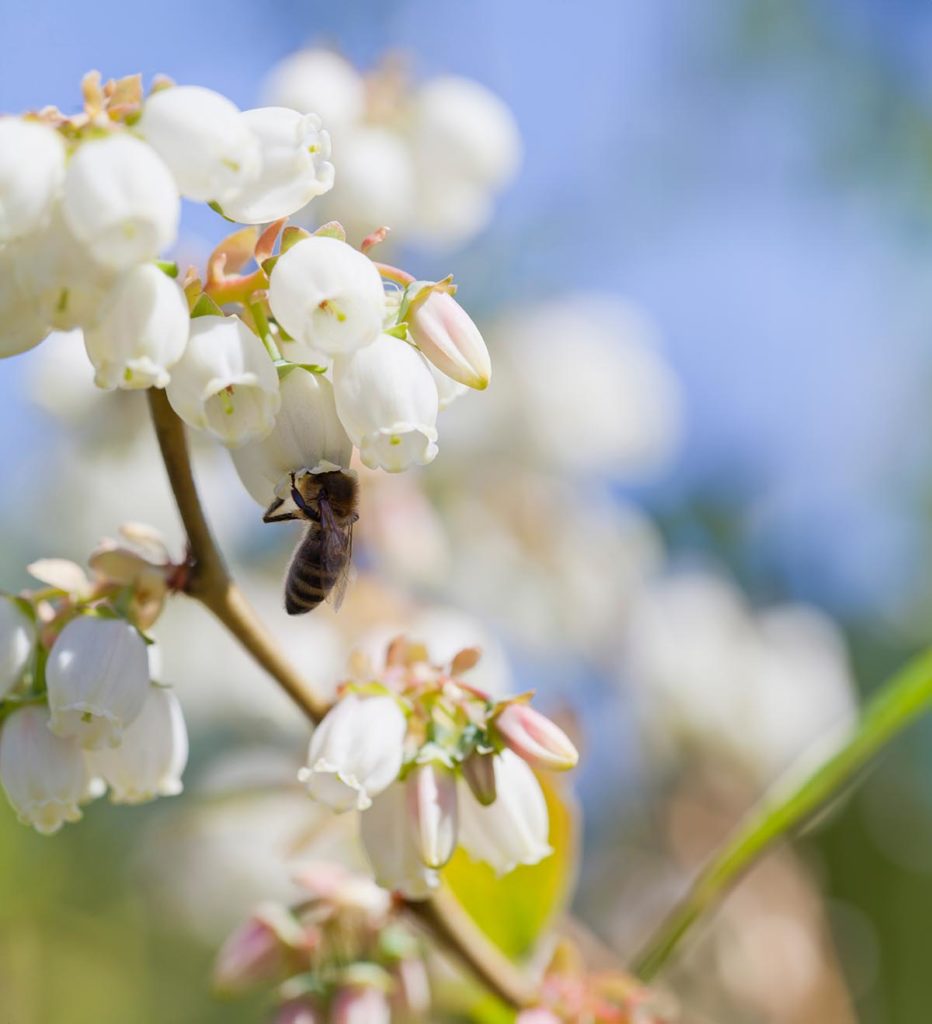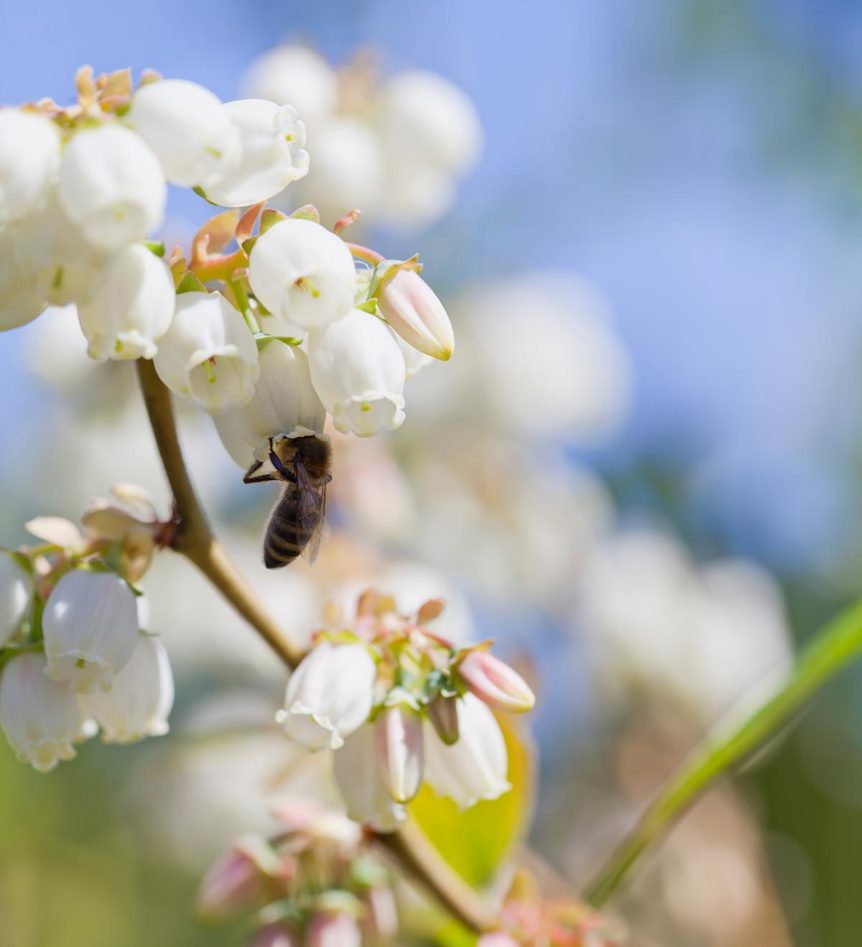
By Frank Giles
Among the critical elements in blueberry production are pollination and crop protection materials. Managing how those two interact is important to ensure pollinators like honey bees are protected.
Recently, Rachel Mallinger, a University of Florida Institute of Food and Agricultural Sciences (UF/IFAS) assistant professor of pollinator ecology and conservation, published a paper on managing pesticide applications during the blueberry pollination period. UF/IFAS colleagues John Ternest and Doug Phillips joined her in authoring the publication.
Honey bees, bumble bees and wild pollinators like southeastern blueberry bee, butterflies and wasps all contribute to the pollination process. All of these insects are susceptible to insecticide and fungicide applications.
“Pesticides with a moderate or even low toxicity can still have sublethal effects on bees, especially if they are applied less than optimally (i.e., during the day to a flowering crop),” Mallinger said. “For example, some pesticides disrupt bees’ ability to find their way back to the colony. Others can impair bee immune systems, making them more susceptible to diseases. Effects on bee health and foraging rates can in turn affect crop pollination rates.”
Pesticide Exposure Routes
Here’s a few ways pollinators can be exposed to pesticides:
- Direct contact with an aerial spray. This is most likely to happen if the pesticide is sprayed during the day and in favorable weather for pollinator activity (warm and relatively sunny).
- Contact with the chemical while it is still active on the crop plant during the period of residual activity. This also includes contact with pesticide residues on flowering weeds within the crop field or in the vicinity of the crop field.
- Drinking contaminated water, which is particularly an issue when pesticides are applied via irrigation. If there are leaks in the drip irrigation system, or if water pools in low areas of the field, bees may drink the contaminated water. Pesticide residues from other modes of application may also be present in surface or groundwater.
- Consuming contaminated nectar and/or pollen is particularly an issue for systemic products. If the pesticide is systemic (i.e., taken up by the plant and expressed throughout the plant tissues), it may be present in the nectar and pollen of the crop plant even well after application. Though the concentration of the pesticide within nectar or pollen is often relatively low, consuming contaminated pollen or nectar can have sublethal effects on adult bees or lethal effects on the bee brood (Yang et al., 2008; Whitehorn et al., 2012; Stoner and Eitzer, 2012).
- Via bee nesting materials, including soil, mud, leaves and other natural materials. Wild bees use a variety of natural materials to create their nests. Contaminated soil, leaves or other materials can harm wild bee larvae living and growing in these nests.
Lethal Versus Sublethal Effects
There are two main ways pollinators can be exposed to pesticides — lethal and sublethal doses. The descriptions are pretty self-explanatory. Lethal doses are measured by a pesticide dose or concentration coming into contact with the insect that kills 50% of individuals. That is designated by the terms lethal dose or lethal concentration (LD/LC 50). The lethal toxicity of pesticide can vary significantly based on pollinator species or growth stage.
In addition to lethal effects, pesticides can have a variety of sublethal effects on bees that include impaired learning and memory in adult foragers, weakened immune systems in adults and brood, and a reduction in reproduction, including fewer new queens or fewer total offspring. These changes in behavior can reduce the level of pollination in blueberries.
Certain fungicides have sublethal effects on bees, like weakening their immune systems. While many fungicides are not considered highly toxic to bees, growers should take care when applying them during the bloom period. This is especially true if the fungicides are being applied along with insecticides. The synergistic effect of the two materials could stack up against the pollinator’s favor.
Picking Products
The general toxicity rating is based on the LC/LD 50 to honey bees measured through contact and/or oral exposure. Note that, counterintuitively, higher-toxicity products have a lower LC/LD 50, indicating that less active ingredient is needed to result in 50% mortality. A high LD/LC 50 conversely means that a large amount of active ingredient is needed to result in 50% mortality, and thus the product is less toxic.
When selecting a product to apply during bloom, it is important to look not only at its toxicity but at whether it is systemic, whether it will persist in the environment (i.e., have persistent residual activity) and whether it may produce synergisms (interactions with other chemicals that may increase toxicity of one or more of the chemicals).
The UF/IFAS publication lists common insecticides and fungicides used in blueberry production and rates their potential toxicity to pollinators. Visit edis.ifas.ufl.edu/publication/IN1429 to see the full publication and toxicity ratings.
Limiting Exposure
Blueberry plants need protection from diseases and pests, so when applying crop protection material, consider the following tips:
- Implement IPM strategies and other control methods to limit chemical sprays during bloom.
- Use existing action thresholds when possible.
- Follow label instructions. Many products with a high toxicity to bees specify that the product should not be applied in any mode of application during bloom and/or when bees are in the crop field.
- When possible, and especially during bloom, select a non-systemic insecticide with a short residual activity and no to low toxicity to bees.
- When possible, avoid using tank mixes of insecticides and fungicides during the bloom period to reduce synergistic effects.
- Apply pesticides, including fungicides and insecticides, in the evening to allow for the longest period of time to pass before bees forage. Cool temperatures and/or wet conditions may prolong residual activity.
- If using a pesticide with a moderate to high toxicity to bees during bloom, be sure to follow label instructions. Also, contact your beekeeper in advance so that they can consider moving or covering hives during application and for a period of time after application.
Beekeeper Communication
A key aspect of protecting pollinators is keeping a strong line of communication open with beekeepers.
“It is very important to communicate your overall pesticide program and discuss what protocols the beekeeper would like you to follow when you are planning to spray the crop,” Mallinger said.
She also recommends that the grower and beekeeper develop a contract to specify what each party is expected to do while the beehives are on the grower’s property. See edis.ifas.ufl.edu/publication/AA169 for a sample contract.










